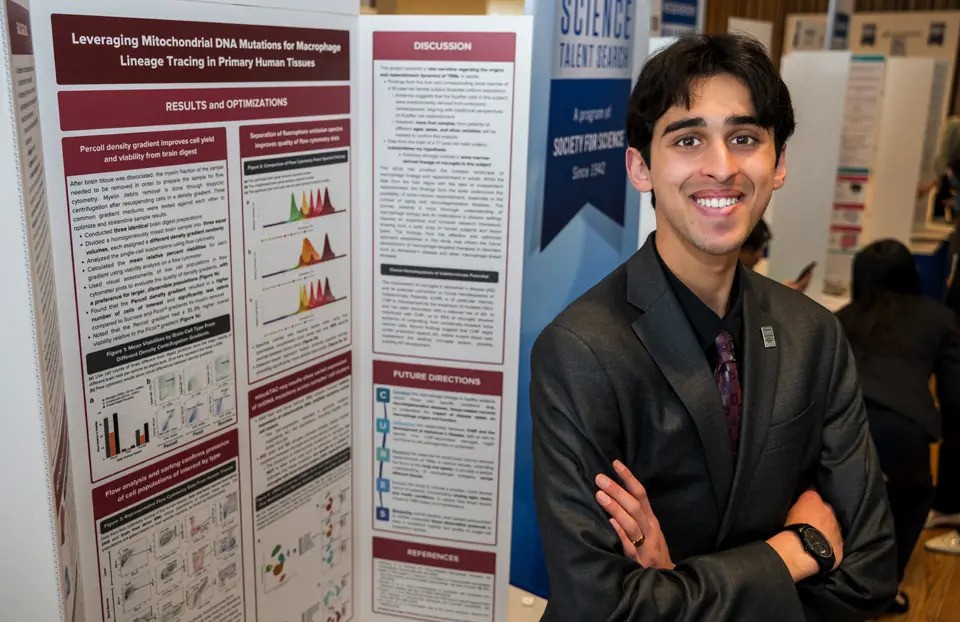(March 17, 2024) Proving the accuracy of President Joe Biden’s statement that “Indian Americans are taking over the country,” numerous Indian-origin youths have consistently excelled in the Regeneron Science Talent Search. Dubbed the “Junior Nobel” of the United States, several high school students of Indian descent have consistently claimed spots among the top 10 finalists in this esteemed STEM competition, renowned for identifying the most inventive young scientists.
Keeping up the tradition, Indian American student Achyuta Rajaram, has been named the winner of the Regeneron Science Talent Search this year too, bagging a cash prize of $250,000. But, he is not alone at the top. A total of 13 students among 40 finalists in this year’s science talent search are of Indian origin. Motivated by pressing challenges that hinder daily progress, these students have devised straightforward, distinctive, and affordable remedies, showcasing their promise as future scientists and innovators dedicated to benefiting humanity. Global Indian puts a spotlight on these young geniuses.
Achyuta Rajaram
At just 17 years old, Achyuta is already making a significant impact in the scientific community. This young innovator devised an automated technique to unveil the segments of a computer model responsible for decision-making when analysing images. This understanding illuminates the cognitive processes of these algorithms, thereby aiding in their enhancement to be more efficient, equitable, and secure.
He enhanced the automated detection of visual circuits through his computer science project submitted to the Regeneron Science Talent Search. In the realm of machine learning, computer algorithms sift through data to address vital real-world inquiries. Achyuta’s research has advanced our capacity to comprehend the inner workings of computer models that discern patterns in images. Specifically, his work sheds light on the thought processes behind these models when analysing photographs and identifies which components of their computational frameworks contribute to decision-making.
But he isn’t just another nerdy kid. Achyuta really likes cats but doesn’t have any at home. So, he used computer tricks to organize 2,300 funny cat pictures. He says it’s a fun way to take a break and enjoy looking at cute cats.
Aditi Avinash
She took the stage to speak on behalf of the Regeneron Science Talent Search Class of 2024 and was named the Seaborg Award winner. Another 17-year-old student of the Rock Canyon High School, Colorado, Aditi discovered that a blend of three enzymes efficiently breaks down gluten proteins, a finding she deems to hold therapeutic promise for individuals with celiac disease or gluten intolerance. She observed that concurrently administering the enzymes proved more effective than administering them sequentially, both in degrading gluten and in diminishing T-cell immune reactions. This discovery could pave the way for novel treatments for celiac disease.

The student’s research suggested that blending the enzymes proved superior in breaking down gluten and lowering the immune response of T-cells compared to administering the enzymes one after the other. She envisions developing a pill to alleviate the discomfort associated with celiac disease and gluten intolerance, enabling individuals with these conditions to consume wheat products without issues.
Arnav N. Chakravarthy
Holding ninth place at the competition, Arnav was granted a $50,000 prize for his investigation into the genetic origins of macrophages, a type of immune cell found in the brain, liver, and bone marrow. His research aimed to shed light on the mechanisms through which these cells regenerate themselves. While many cells can be traced back to their embryonic origins, Arnav uncovered evidence suggesting that specific brain cells might also be replenished from our bone marrow as we grow older. His discoveries have the potential to inform future targeted treatments for age-related ailments such as Alzheimer’s disease.


In order to evaluate this hypothesis, Arnav employed a genomics tool to track the origins of brain and liver samples, alongside bone marrow samples sourced from the same donors. He then compared the lineage and distinctive mutations of the cells. His results indicate the potential for the regenerative capabilities of macrophage cells, which could have implications for age-related conditions such as Alzheimer’s disease.
Saraswathy Amjith
A nonprofit founder and president offering free teaching and tutoring to more than 200 underserved students, Saraswathy devised a method to enhance the precision of identifying illegal logging as part of her environmental science project for the Regeneron Science Talent Search. She aimed to develop a tool for detecting illegal logging. She conducted experiments with different machine-learning techniques, leveraging satellite-based remote sensing data to identify the most effective approach for detecting logging activities. Given the challenge of cloud cover in tropical regions hindering satellite imagery’s effectiveness, Saraswathy integrated both optical and radar imaging methods to achieve more precise detection results.


In her project, Saraswathy discovered a way to mitigate the impact of cloudy weather by merging satellite optical and radar datasets, as radar imagery remains unaffected by clouds. Subsequently, she evaluated different machine learning methods to ascertain the most effective approach for this particular application.




